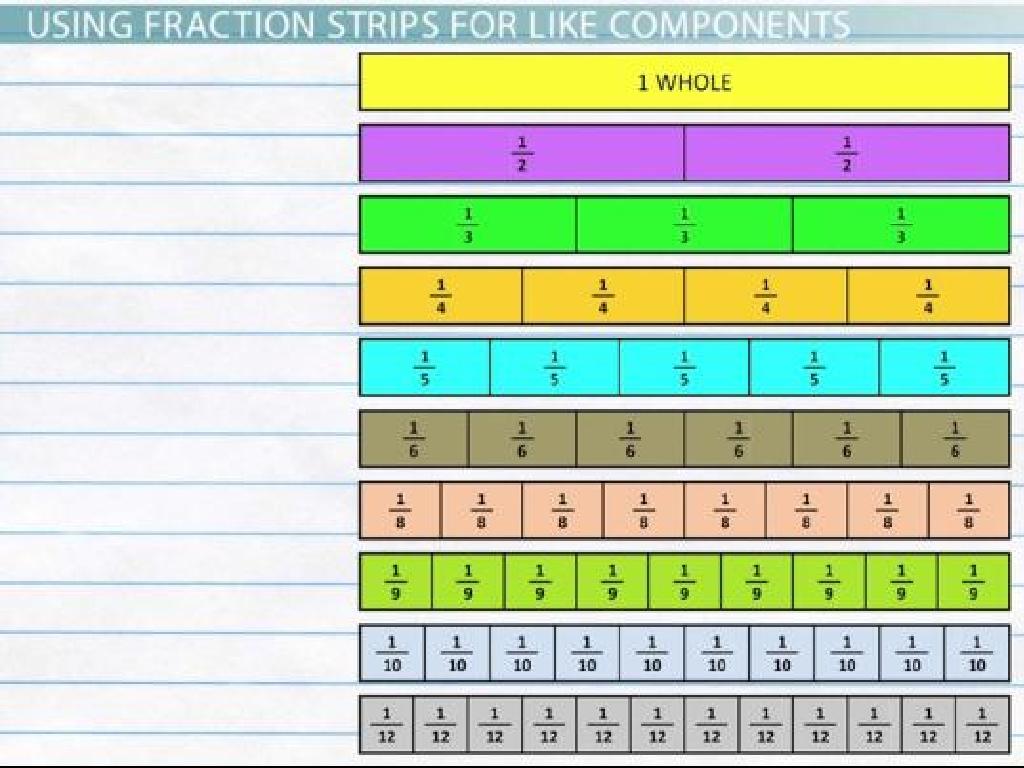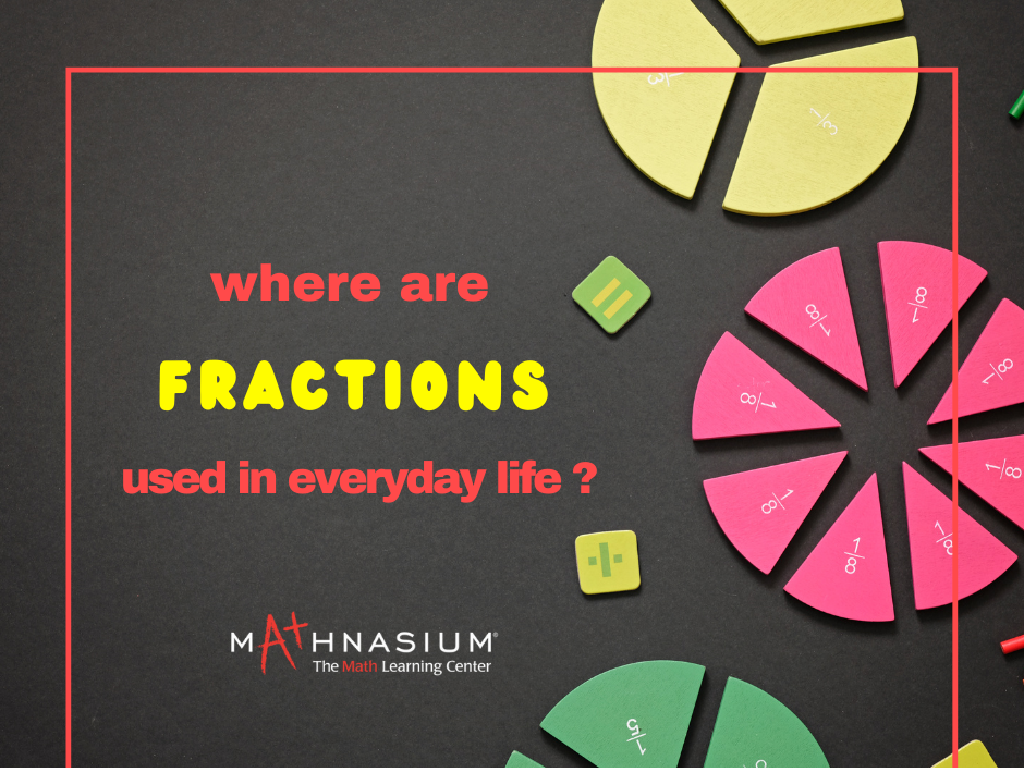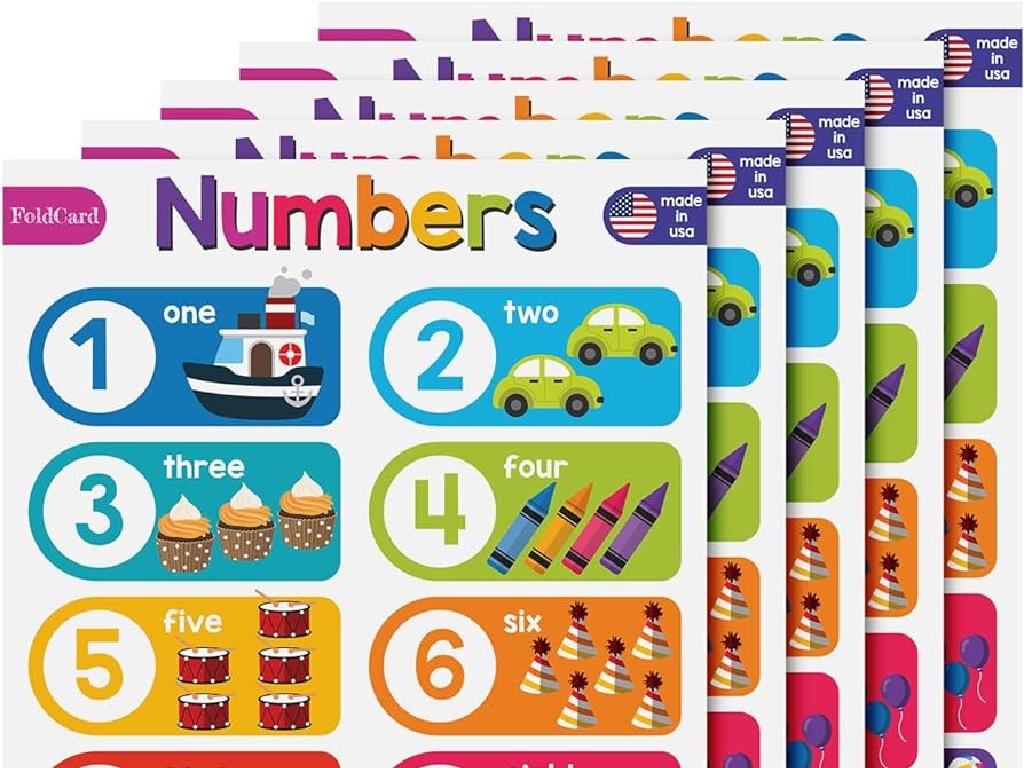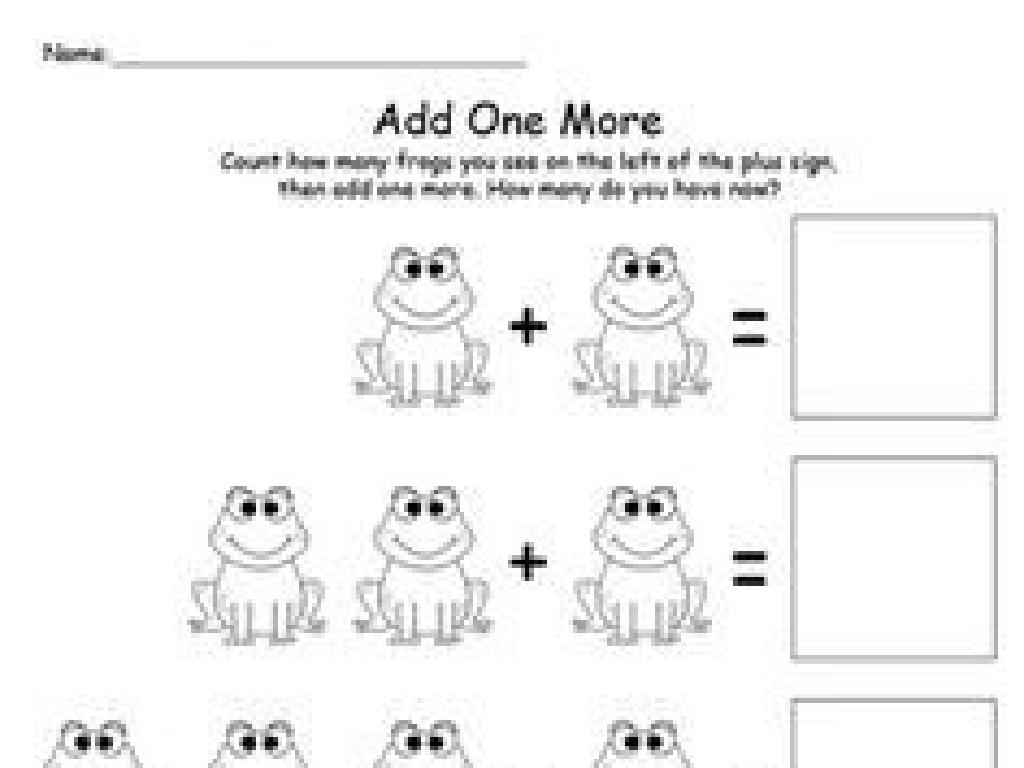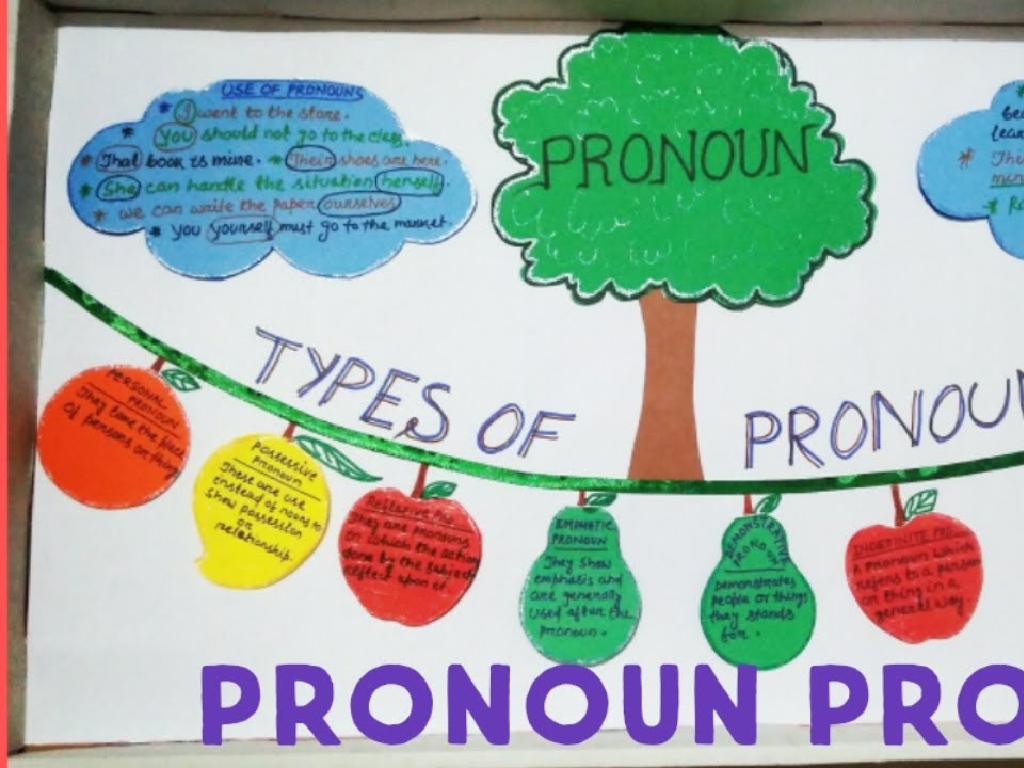Multiply Unit Fractions By Whole Numbers: Word Problems
Subject: Math
Grade: Fourth grade
Topic: Multiply Unit Fractions And Whole Numbers
Please LOG IN to download the presentation. Access is available to registered users only.
View More Content
Today’s Adventure: Multiplying Unit Fractions by Whole Numbers!
– Quick recap on fractions
– Fractions represent parts of a whole
– Exploring unit fractions
– Unit fractions have a numerator of 1
– Multiplying fractions by numbers
– Multiply the whole number by the numerator
– Solving real-world problems
– Use examples like pizza slices or sharing candies
|
Begin with a brief review of what fractions are, emphasizing that they represent parts of a whole, which is a concept fourth graders should be familiar with. Introduce unit fractions, explaining that they have a numerator of 1, which means they represent one part of the whole. Demonstrate how to multiply a unit fraction by a whole number by multiplying the whole number by the numerator of the fraction. Provide real-world examples, such as dividing a pizza into equal slices or sharing candies among friends, to illustrate these concepts. This will help students visualize the process and understand the practical application of multiplying unit fractions by whole numbers.
Understanding Unit Fractions
– Unit fractions represent parts
– Each unit fraction is one part of a whole, like one piece of a pie
– Examples: 1/2, 1/3, 1/4
– Common unit fractions we see every day
– Numerator is 1 in unit fractions
– The top number of a fraction shows how many parts we have
– Denominator defines the parts
– The bottom number shows into how many equal parts the whole is divided
|
This slide introduces the concept of unit fractions, which are fractions where the numerator (top number) is 1. It’s crucial for students to grasp that the denominator (bottom number) of a unit fraction divides the whole into equal parts, and the numerator indicates how many of those parts we are considering. Use everyday examples like slicing a pizza or a cake into equal parts to illustrate the concept. Encourage students to think of unit fractions as a single piece of a divided whole, which will help them when they begin to multiply these fractions by whole numbers in word problems.
Multiplying Whole Numbers by Unit Fractions
– Understand multiplication with fractions
– Multiplying a whole number by a fraction means splitting into that many parts.
– Visualize with real objects
– Use items like pizza to show parts of a whole.
– Example: Multiplying pizzas
– If you have 3 pizzas and cut each into 4 pieces, you have 3 x 1/4 slices.
– Practice with word problems
|
This slide introduces the concept of multiplying whole numbers by unit fractions through visualization and practical examples. Start by explaining that when we multiply a whole number by a unit fraction, we are essentially dividing the whole into smaller parts. Use tangible objects like pizzas to help students visualize the concept; for instance, cutting 3 pizzas into quarters gives us 3 groups of 1/4 slices. Encourage students to draw pictures or use physical objects to understand the multiplication process. Conclude with word problems that apply this concept, ensuring students can translate a real-world scenario into a mathematical equation involving multiplication of whole numbers by unit fractions.
Multiplying Unit Fractions by Whole Numbers
– Solve real-life fraction problems
– Use multiplication to find parts of a whole in scenarios like sharing pizza
– Read the problem with attention
– Understand every part of the story to find clues
– Find the unit fraction in the problem
– A unit fraction has a numerator of 1, like 1/4 of a cake
– Locate the whole number to multiply
– This is the number of times you take a fraction of something, like 3 groups of 1/4 cake
|
This slide aims to help students apply their knowledge of multiplying unit fractions by whole numbers to word problems that mimic real-life situations. Emphasize the importance of reading the problem carefully to understand the scenario fully. Guide students to identify the unit fraction (a fraction with a numerator of 1) and the whole number that represents how many times the unit fraction is being considered. Provide examples such as dividing a pizza into equal parts or measuring ingredients for a recipe. Encourage students to visualize the problem and use drawings or objects to represent the fractions and whole numbers involved. This will help them grasp the concept of multiplication as repeated addition.
Let’s Practice Together: Multiplying Fractions
– Example: 1/2 cup used 4 times
– Step-by-step solution
– Multiply 1/2 by 4 to find total cups
– Discuss with classmates
– Share your thoughts on the solution
– Understand the process
– Grasping multiplication of fractions
|
This slide is an interactive class activity designed to help students understand how to multiply unit fractions by whole numbers through a practical example. Start by presenting the problem of needing 1/2 a cup of ingredients used 4 times. Walk the students through the multiplication process: 1/2 cup x 4 = 4/2 cups, which simplifies to 2 whole cups. Encourage students to discuss their approach to solving the problem with their classmates to foster collaborative learning. This will also help them to hear different perspectives and methods. The goal is for students to become comfortable with the concept of multiplying fractions by whole numbers and to apply this knowledge to solve word problems. Provide additional examples if time allows and ensure to clarify any misconceptions.
Try It Yourself: Multiplying Fractions
– Solve fraction word problems
– Use drawings to visualize
– Draw pies or bars to see the fractions
– Work alone or with a partner
– Share your methods and answers
– Explain your thinking to the class
|
This slide is designed to engage students in hands-on practice with multiplying unit fractions by whole numbers through word problems. Encourage students to solve problems independently or collaborate in pairs to foster teamwork. Visual aids like drawings or physical objects can be instrumental in helping students understand abstract concepts. After solving the problems, students should be prepared to discuss their solutions and the strategies they used, promoting a collaborative learning environment. For the teacher: Prepare a variety of word problems that apply multiplication of unit fractions by whole numbers. Have manipulatives ready for students who need concrete examples, such as fraction bars or pie models. Circulate the room to assist and challenge students as needed. Be ready to highlight different methods used by students during the sharing session to showcase diverse thinking.
Class Activity: Fraction Multiplication Art
– Create art with fraction multiplication
– Cut a sheet into unit fractions
– Each piece represents a unit fraction of the whole
– Multiply fractions by whole numbers
– Example: 1/4 x 2 = 1/2, make two 1/4 pieces to create a 1/2 section
– Design patterns with multiplied fractions
– Use the pieces to form creative patterns on a larger canvas
|
This activity combines art with math to help students understand the concept of multiplying unit fractions by whole numbers. Provide each student with a whole sheet of paper and instruct them to cut it into unit fractions (e.g., halves, thirds, fourths). Then, they will multiply those unit fractions by whole numbers to create different-sized pieces. For example, if a student multiplies 1/3 by 3, they will use three 1/3 pieces to create a whole. Students will use their multiplied fractions to design patterns or pictures, reinforcing their understanding of the concept through a hands-on activity. Encourage creativity and ensure they grasp the multiplication process. Possible variations include using different colored paper for different fractions, creating a class mural with everyone’s pieces, or challenging students to represent a specific scene or object using their fraction pieces.
Review and Reflect: Multiplying Unit Fractions
– Understanding unit fraction multiplication
– A unit fraction has a numerator of 1. When we multiply it by a whole number, we’re finding parts of a whole.
– Real-life application of fraction multiplication
– This helps in situations like cooking or dividing items evenly among a group.
– Share an interesting takeaway
– Maybe you enjoyed learning how to multiply fractions to split a pizza among friends!
|
As we wrap up today’s lesson, let’s reflect on the concept of multiplying unit fractions by whole numbers. This fundamental math skill is not only important for academic purposes but also has practical applications in everyday life, such as cooking or dividing things evenly. Encourage students to think about how they can apply what they’ve learned outside of the classroom. Ask them to share one aspect of the lesson that they found particularly interesting or enjoyable, which can help reinforce their understanding and make the learning experience more personal and memorable.
Homework Challenge: Fraction Multiplication
– Practice word problems at home
– Share your solutions next class
– Discuss how you solved the problems
– Did you draw a picture or use objects?
– Remember, practice is key!
|
This homework challenge is designed to reinforce the concept of multiplying unit fractions by whole numbers through additional practice with word problems. Encourage students to try different methods to solve the problems, such as drawing models or using physical objects to represent the fractions. Remind them that making mistakes is a part of learning and that practice will help them improve. In the next class, provide an opportunity for students to share their answers and explain the strategies they used. This will help them learn from each other and gain a deeper understanding of the topic. Prepare to offer guidance and clarification as needed.

